I've chosen the track at California State University, Northridge as my first
example. Below each picture are the notes.
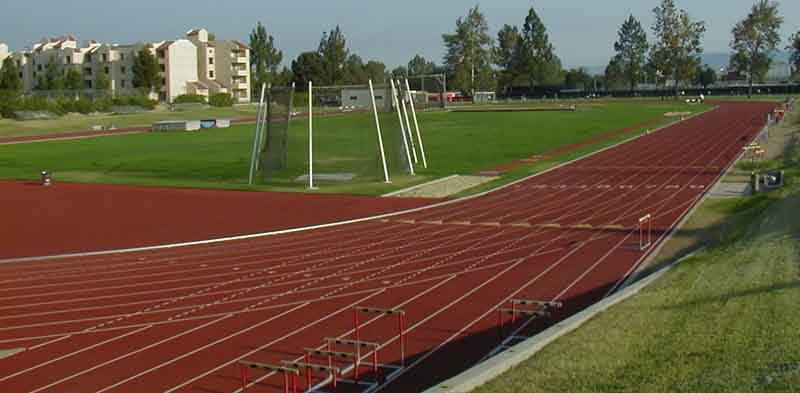 | This is not
a perfect track and I will elaborate on the mistakes they have made. But I did
not pick this track to bag on CSUN, quite the contrary. Of all the tracks in
my immediate area, this is the BEST marked track. In fact they have put some
good ideas into place, which I will also point out. They also have used most
of the options I have mentioned. |
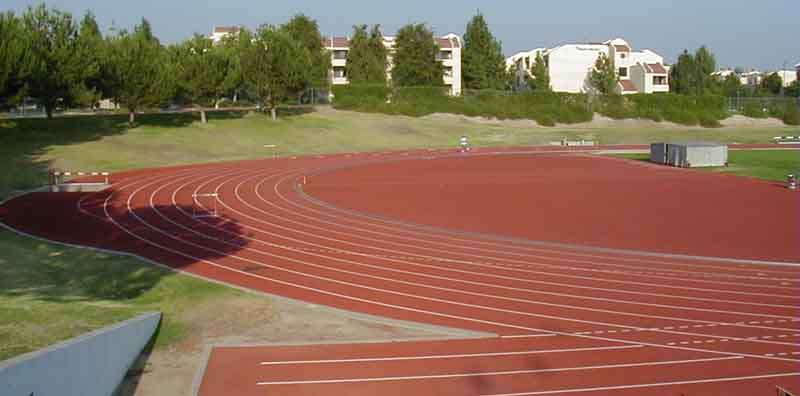 |
They obviously have a steeplechase pit built on the outside. That is
a dotted line leading the (measured) course to and from the pit. In the
foreground, the chute is cut into a hillside. At 140m, this is more straightaway
than is necessary.
|
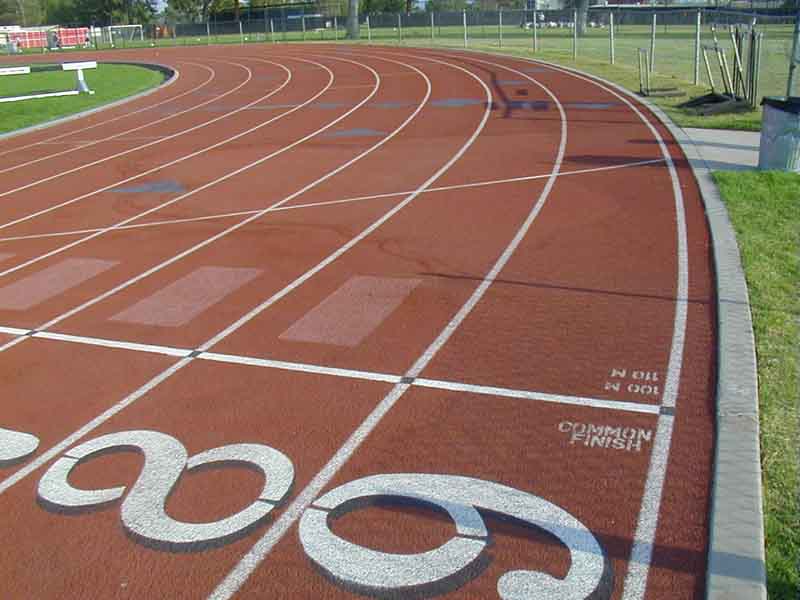 |
One particularly good
thing they have done is mark what the lines mean--most tracks do not do this.
So here the common finish is easy to find. The upside down 100M and 110M in
lane 9 shows this is (frequently) the start line for races run in the reverse
direction on the home stretch. They have had so much wear here that they had
to repair sections of the lanes--thats what the boxes are behind the starting
line. The starting blocks use spikes to hold them in place and that constant
use in the center of each lane tore out a small section of the surface. The
black boxes on the common finish line are for aligning the photoelectronic timer
on that line. The sets of blue triangles are both for the 4x400 relay. The staggered
ones are for the first exchange. Wherever triangles are used, the point of the
arrow points into the zone (but its size is not specific), the flat side is
the edge of the zone. The triangles in a row are all the end of the zone for
exchange 2 and 3. The curved line is the waterfall start line for lap races.
It is marked "10000" because that is the only collegiate race that
starts from such a line, but it is also the start for races like the 1600, 3200
or a distance medley relay. |
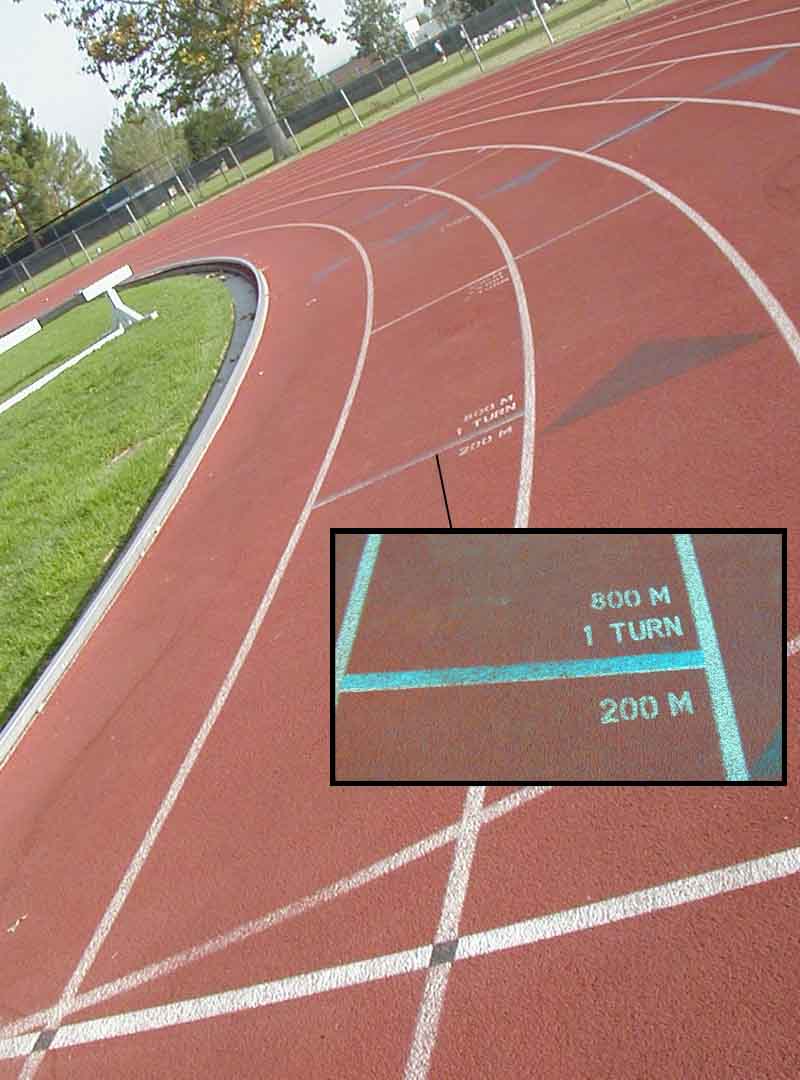 |
Lane
2, starting at the common finish line usually provides the definition of the
track you are standing on. CSUN marked what each line means which defines their
color code. From the common finish line in the foreground, the first line is
the reverse 200m start. Getting artistic, I included the inset to show a close
up of what is at this line. The blue line (which should be green) almost on
top of the white line is the 800m 1 turn stagger line. These are two different
lines for the start of two different races--while they are used interchangably
at most tracks because they are so close, they are not interchangable. The photo
below shows how the 800m start lines progressively get further away from the
white reverse 200m start lines as you move out in lanes. The black triangle
(which should be red) in lane 3 is the beginning of the second 4x200 4-turn
passing zone. |
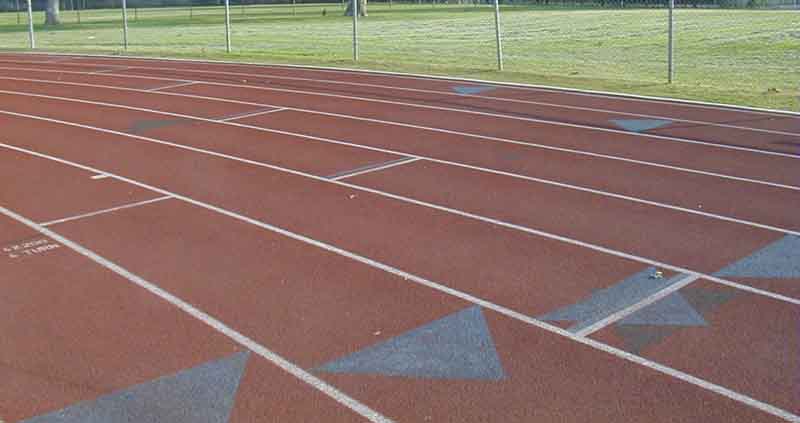 |
In lane
4, there are four marks on top of one another--the significant part of each
mark still shows. There is the white reverse 200m start line, the blue (should
be green) 800m start line, the black (should be red) 4x200 beginning of the
second zone triangle and the blue end of 4x400 (second and third) passing zone.
The start lines are really the front edge of the lines, while the wide ends
of the triangle are the significant lines. |
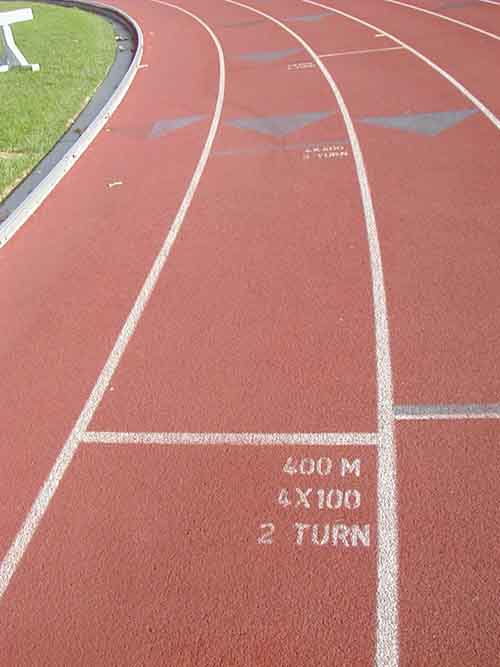 |
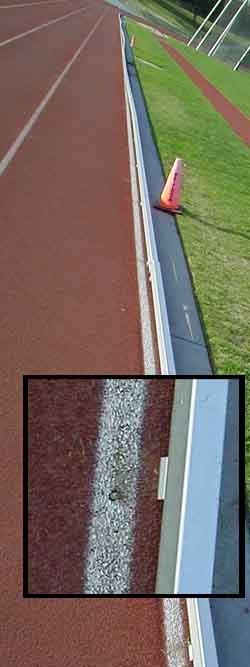 |
The 2 turn stagger is clearly marked, along with the races that apply
to it. Right next to it in lane 3 are the reverse 200m and 800m (should
be green) start lines. The line is the blue 3 turn stagger. Then the row
of triangles indicating the end of the 4x400 passing zone. In lane 1 the
triangle is split, half blue half black (should be red) to indicate this
mark applies to both the 4x400 and (in lane 1 only) 4x200. Around the
curve, you can see the curb is on the white line, bringing up the question
of the accuracy of the measurement of the entire track.
|
The curbing at CSUN is definitely marked wrong. You can see the curb
has broken off of its mounting screws and waves all over the place. From
the inset you can see they intended the curb to mount on the white line.
By the rule book, if a white line exists the outer edge should be 10cm
from the curb (5cm to the inner edge and 5cm wide).
|
Now the question is; did they measure the track 20cm from the line, meaning
the curb is in the wrong place and runners are running about 2/3 of a meter
too long per lap, or did they put the white line in the wrong place and possibly
measure all the other lane lines wrong relative to it? To start to answer that
is; if lane 1 is 10cm wider than the other lanes, means they properly placed
the curb and (we assume) properly measured 30cm from the curb. Without pulling
out a measuring tape, this is really only known by whoever measured the track
and possibly whoever keeps that surveying data on file, possibly the track coach.
If a record is set, we are talking about 9 feet per mile, which is significant.
Again, I say this not to pick on CSUN, this happens all over the place. Wherever
you go, if you are an outsider, who really knows?
To answer questions above for this particular situation, I did pull out a
measuring tape and found that lane 1 is just as wide as the other lanes. Then
I had to go the next step, I measured the radius of the track, curb to curb
(63.46cm) within the level of accuracy one can do with a measuring tape. This
is only possible to do because they did mark a spot the same distance from the
turn on both sides of the track--in this case it is the 300m start line and
the common finish line (without this information, you could not be sure if you
were exactly straight, edge to edge). Adding the 20cm to each side, and multiply
by pi and the answer is the curb is in the wrong place (white line is
in the correct place), thus the runners are officially running over two feet
longer than necessary per lap. I guess that is better than the track being too
short in any condition. Not everybody would drive around with a 100m measuring
tape--in other words, we should just be able to assume things are done
right at whatever track we walk onto. Obviously we can't--you should know your
rules and look at things with an eye towards what is right (so you will notice
if anything is wrong). We should consider ourselves fortunate we even have a
curb here. So many tracks these days are being built without a curb, even though
the rule book still calls for one for records to be accepted. And if I've put
the credibility of a record at CSUN in doubt, if a record has been set at a
distance over 1 lap at CSUN, it would be certainly be accepted because the athlete
would have gone too far. I've probably editorialized on this enough.
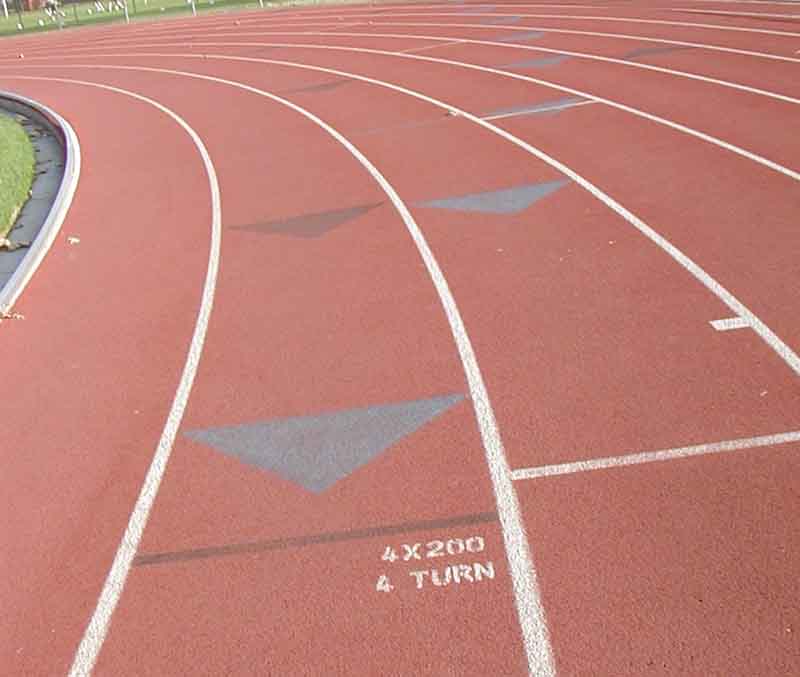 |
The
4x200 4 turn start is the next start line in lane 2. This should be red along
with the triangles that correspond to this relay. I will guess the painters
made an artistic decision to deviate from the rule book because the base color
of this track (like most tracks) is a redish orange and they thought it would
be hard to see. I only quote what the rule books call for. The white line in
lane 3 is the 400m 2 turn stagger start line. Just beyond that on the outside
of lane 3 is a white box that is the marker for the steeplechase barrier that
you will see in previous pictures is waiting inside of the track. There are
four steeplechase marks like this, plus the water jump spaced evenly around
the course the steeplechasers follow. This picture shows how staggered lines
progress incrementally as you move out lanes. |
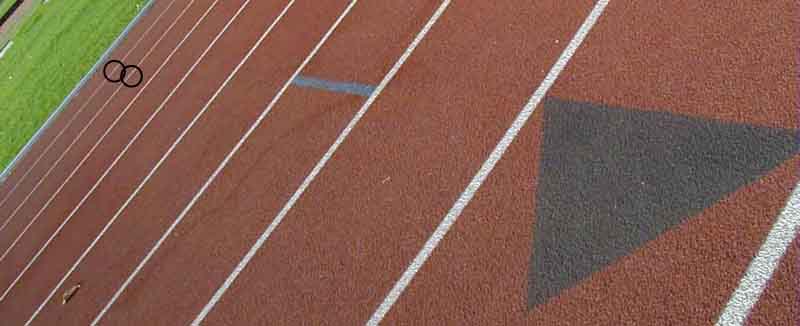 |
Moving
halfway around the first turn, you see in the foreground, the 4x200 passing
zone is just completing, the 4x400 3-turn start line for lane 7 and in the circles
in lane 2 are the blue 400H marks. They obviously did not bring green paint
with them when they painted here, because these hurdle marks also should be
green and this will become significant later around the track. |
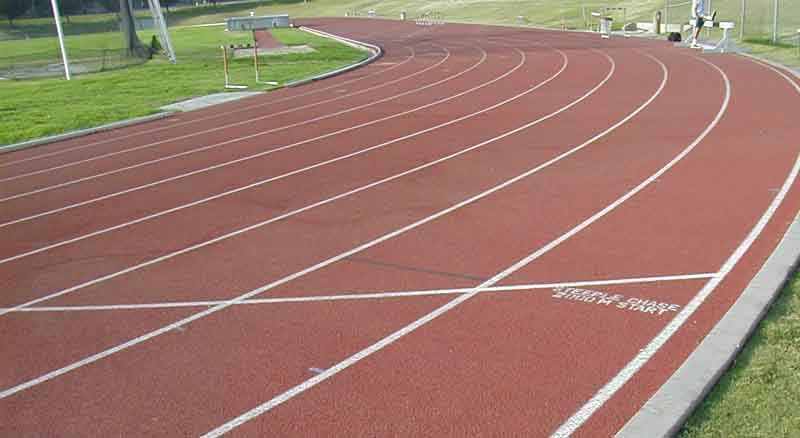 |
We
are now most of the way through the first turn but in lane 8 we have just reached
the first 400H marks and later the 4x200 start line (lane 9 is even further
into the turn). The white waterfall line in the foreground is (clearly labeled)
the 2000m Steeplechase start line. Over the last decade the women's steeplechase
has been evolving into acceptance. At points in time over the evolution of this
new event, they had prescribed a 2000m (2K) distance and then standardized the
distance at the same 3000m (3K) the men run. Many colleges marked the 2K, which
is still applicable in Masters and Youth divisions. |
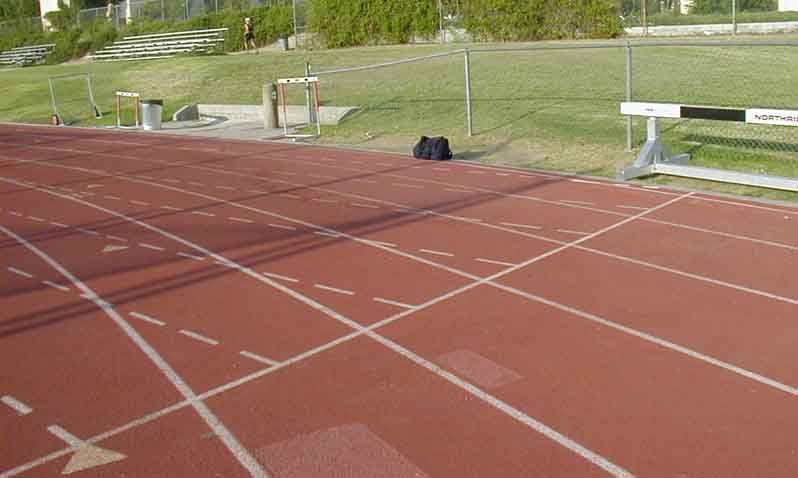 |
As we reach the back stretch we see they have marked it for reverse
hurdles and sprints. The white start line in the foreground is the reverse
100H start line. The dotted lines show the continuation of the straightaway
into the turn--lane 9 does not exist that far and part of lane 8 is chopped
as well. Again the boxes indicate where they wore out and repaired the
surface where the starting blocks go, particularly in lanes 3-5. The next
picture on the right shows the wear in lanes 8-9 at the 100m start. They
obviously practice with the men's hurdles in the middle of the track and
the women's hurdles on the outside of the track. Even more specifically,
that picture shows a spot in lane 8 where the left foot of standing starters
has repeatedly worn a new hole (it is even worse in lanes 5-7). Doing
anything in the same spot for years will cause wear. Lane 1 gets the most
usage by far, that is why most tracks discourage joggers from using lane
1. My point is: the spikes from starting blocks are, by far, the most
destructive force (far more than an overweight jogger, dragging his flats
around lane 1).
Continuing on, in lane 4 foreground is a small yellow triangle--that
is the beginning of the acceleration zone for the first 4x100 relay. The
outgoing runner can stand as far back as the back of that triangle, but
cannot touch the baton until it passes the next (large) yellow triangle
in that lane. At exactly the same spot as that acceleration zone begins
is the second 400H mark (which should be green but is blue here).
|
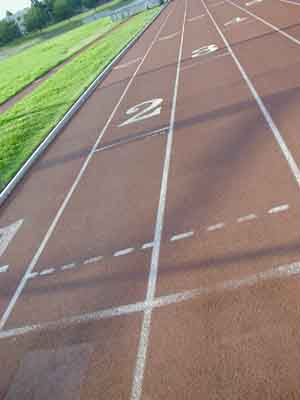 |
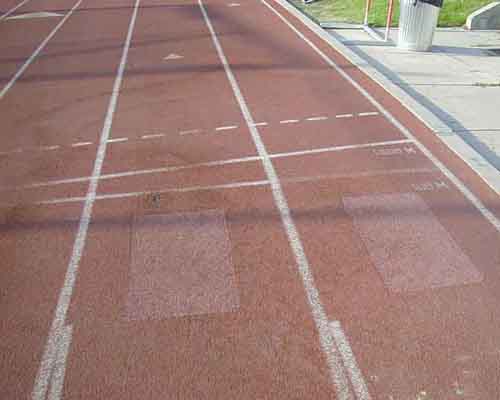 |
Ten meters further we are at the start of the back stretch where the
staggered start lines are for the 300m (usually meaning the 300H). The
dotted line is the break line for this track--which again should be green.
This track has 100m straightaways (not all do) so I do not understand
why that line is not actually at the beginning of the straightaway here--in
fact the 1500 meter start line is measured to the same tangent and could
easily serve as the same line. Maybe they just wanted it to be a different
line. It does not extend into lane 1 because that lane does not break.
One has to assume all the measurement of the start lines corresponds with
the positioning of the waterfall break line, and in theory that break
line could be anywhere on the straightaway, but normally you would give
the athletes the maximum amount of straight to the tangent to break.
|
On the outside of the track, is the sign for the reverse 100m start
line. The waterfall start line that starts in the same spot in lane 1
is the 1500m start line. It is not curved nearly as severely as the waterfall
at the common finish because the runners have a full straightaway to break
to the inside, so the distance on a tangent to a common marker varies
much less from inner lanes to outer lanes.
|
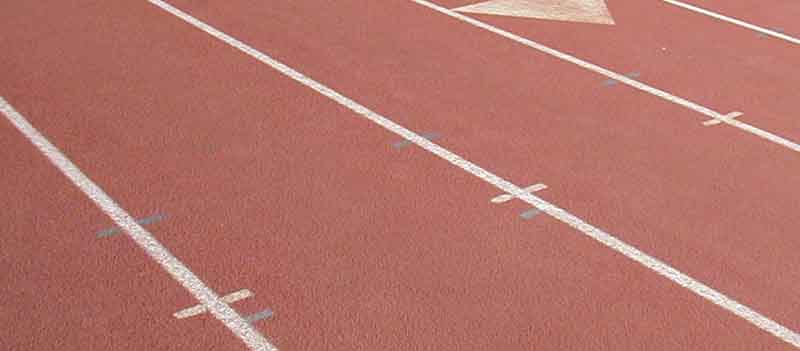 |
Moving
down the straightaway, we see three sets of hurdle marks, two blue, one yellow.
The first marks, the ones only in one lane are the 400H marks and should be
green. The yellow mark is correctly colored and is the womens 100H mark, the
other blue mark that is in the same place in each lane is the mens 110H mark.
This is how not having the correct color can confuse your hurdle crew. Think
about it, your hurdle crew is usually NOT someone familiar with hurdles because
the hurdlers are getting ready for their race. It would be so much easier to
tell the baseball team that is working as the crew to put a hurdle at the middle
height on every green mark, than to have to explain or locate these marks for
them. |
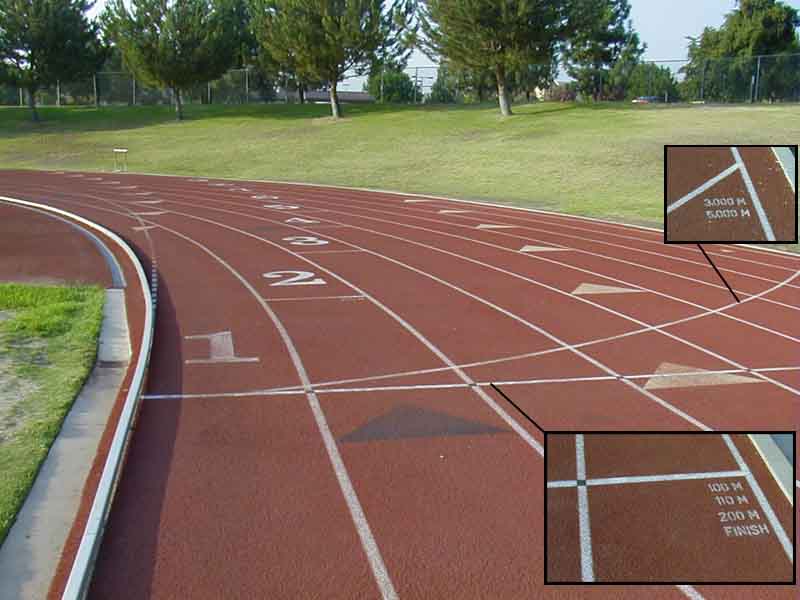 |
At the other end of the straightaway is the reverse finish line--the
straight line that extends across the track would otherwise be unnecessary.
The start lines for 200m (staggered) and races that involved half laps
like 3000m/5000m (waterfall) are also here. This finish line is also marked
for phototiming (the black boxes on the finish line). The yellow triangles
are the second 4x100 passing zone (which also serve as the third 4x200
passing zone) and the black triangles (which should be red) are the first
4x200 passing zone. Again notice lane 1 has a split triangle, this time
to show its dual purpose between 4x100 and 4x200. Barely perceptable is
the black (should be red) small triangle (just above the box in lane 3)
defining the accelaration zone for the 4x400. Behind us, that small triangle
is also split in lane 1. The dotted line leaving the curb is the steeplechase
course taking those runners in an arc across the track to the outside
water jump and then returning them to the curb.
|
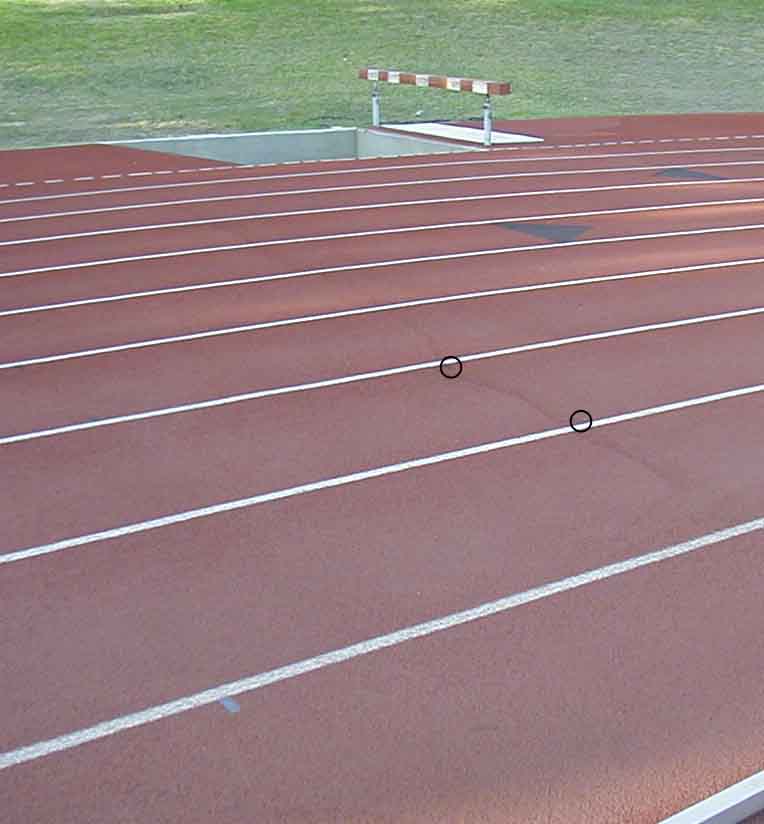 |
In the middle of the next turn we see in the foreground, the blue (should be
green) marks for 400H and within the circles are black marks (which should be
red) for the 300H. Those staggered 4x200 marks extend well into the turn in
the outer lanes. The dotted white line continues out to the steeplechase pit,
which is full of water when in use. |
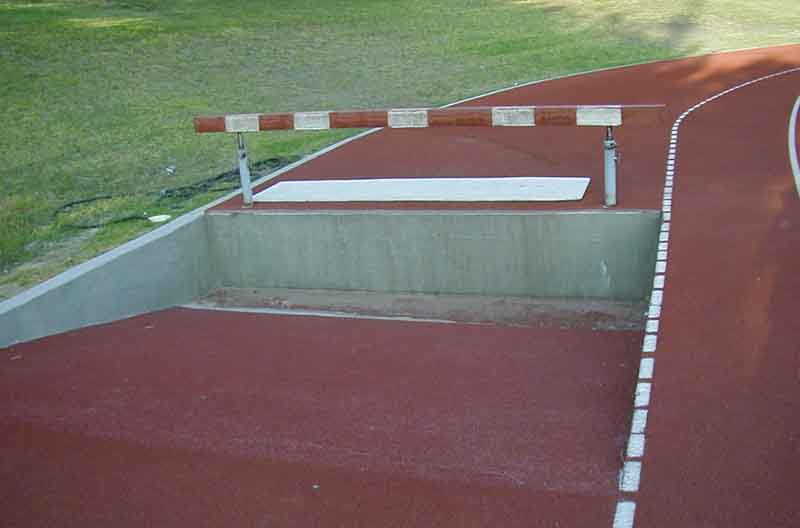 |
They just use a hose to fill the water jump and there is a drain (control
in a hole next to the hose) that can be turned on and off like a bathtub.
Novice meet directors should learn it takes time to fill the pit with
water, if the hose is slow it could take an hour--plan your schedule accordingly.
The plywood under the barrier is placed against the barrier to provide
the runners with depth perception. Running at speed in sloppy wet shoes
while exhausted can alter one's ability to see a 5 inch wide bar. But
the proper placement of one's foot on this bar is critical to the efficient
jump over the water (or conversely a brutal belly flop into it). No, you
can't just go around it--that's not how the race works.
|
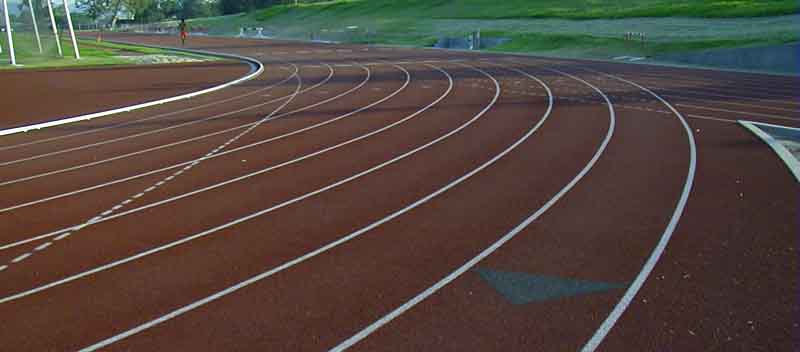
|
Coming out of the far turn back to the home stretch, the steeplechase course
return to the turn. The small triangles in the distance are the acceleration
zone for the third 4x100 passing zone. They are all in a row because the stagger
is almost even by this point. Now here's the question. I have no idea what a
blue triangle is doing in lane 9 here. My guess is they screwed up and painted
the 4x200 zone the wrong color (or possibly this is a photographic problem).
Even for their wrong colored color code, this should be black (by the rule book
it should be red). |
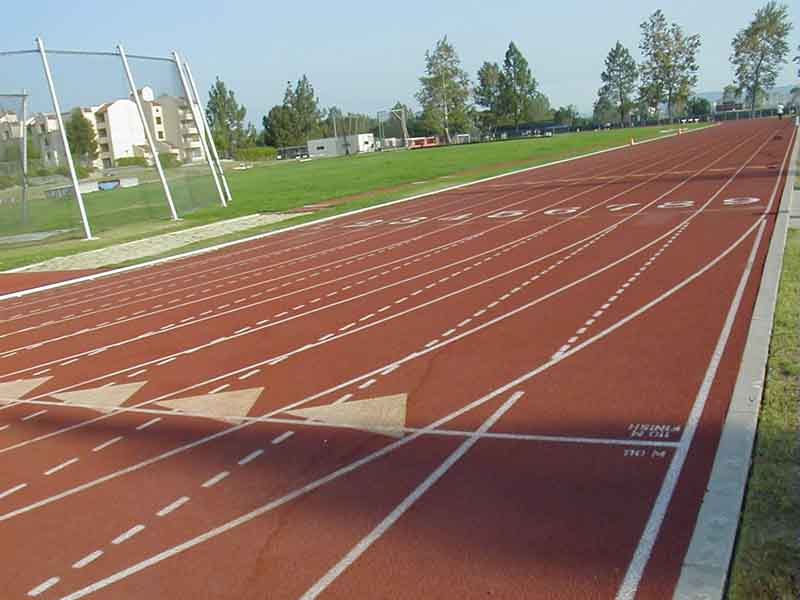 |
|
|
This is the normal direction 110H start line (and as indicated by the upside
down lettering) is also the reverse 100H finish line. The triangles are the
beginning of the relay zones are exactly the same distance from the finish line
but apply to the curved lanes rather than the straightaway for the hurdles.
The 8th 400H mark is also at the edge of these triangle. |
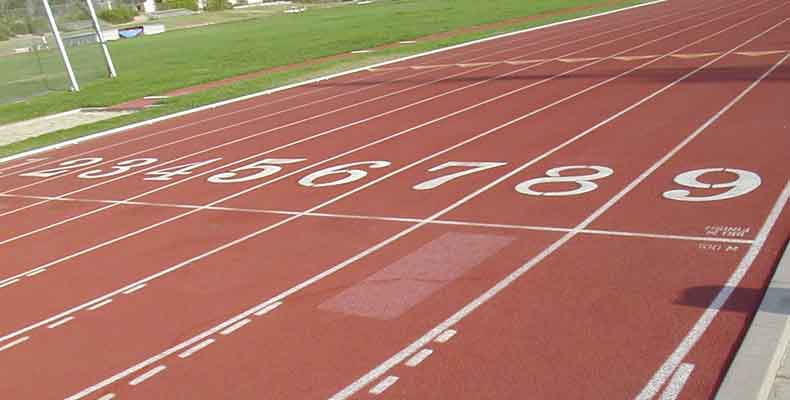 |
|
|
Here is the 100m start line. On this track with 100m straightaways,
this is the point at which all staggers resolve themselves. From here
all runners are even for the final 100m to the finish. Again they have
had to repair the place where the starting blocks have worn out the original
surface. Notice at most major start lines for races that do not involve
a break, the lanes are numbered. If you see a line painted across the
middle of the end of 3rd zone arrows, that is probably 100 yards. Its
not here but it still exists on some older tracks, particularly imperial
tracks.
|
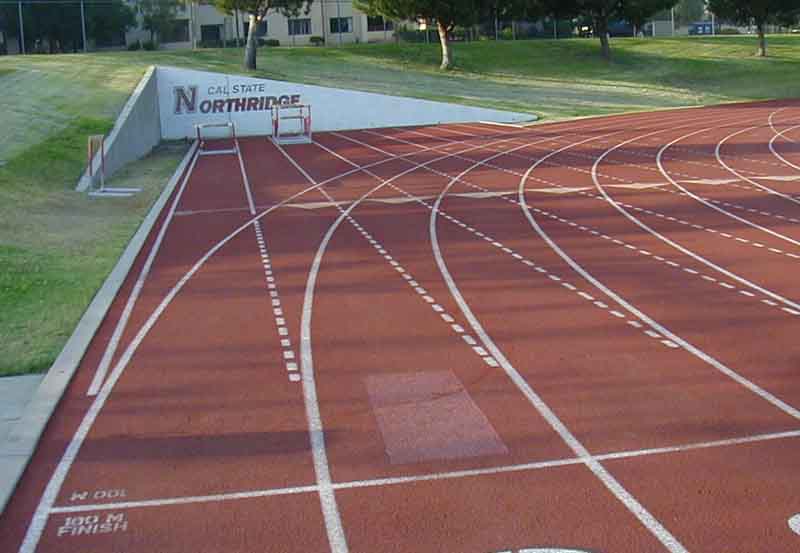 |
This is a chute. The CSUN chute is 30m longer than necessary here.
Its not a problem to have an extra long chute, it gives you an additional
area to wear out practicing sprints and hurdles. They obviously had to go
through a lot of extra work to build the retaining wall with the sign to
have this chute. Where space and budget are a consideration, all that is
necessary is the notch to provide a 110H start line in the outside lane
(plus a little room for the athletes to walk up to where the blocks are
set for that race). The wider the turns or more offset your finish line,
the more chute you need. Some places also have a chute at the end of the
sprint straight, but I've never heard a discussion about how to finish.
Some athletes take the turn, even when given the option, others go straight
even when there is nowhere to go but into their neighbors lane. |
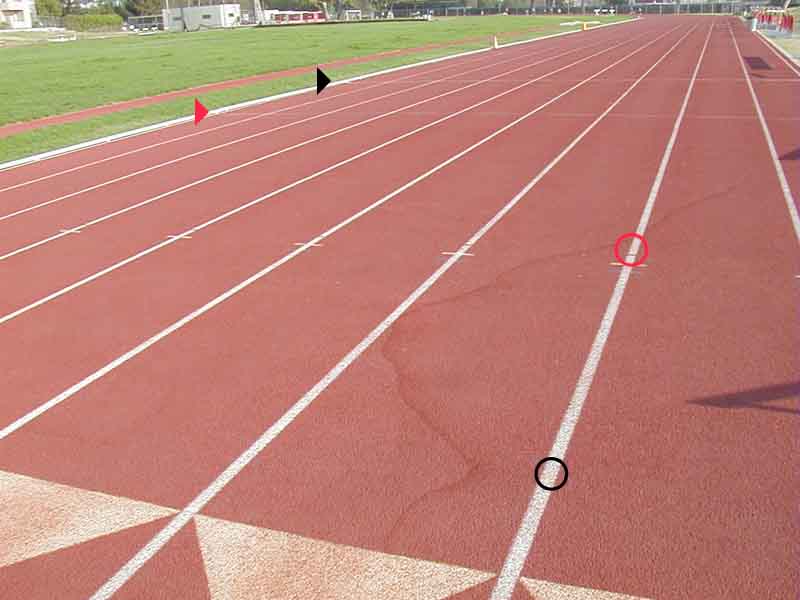 |
Here are the various hurdle marks on this track. In the foreground
circle is a fain yellow mark on the lane line. It is the reverse 100H
mark--it is 10.5m before the finish line, so in the reverse direction
that would put it .5m before the 10m relay zone. In the red circle is
the reverse 110H mark, also a dot (this time blue) on the lane line. These
marks on lane lines are this track's way to show they are different from
the normal direction hurdle marks which are the blue and yellow marks
in the lanes. When faced with double 110H marks, the ones for that race
are always the ones 1 foot closer to the start line. If you run shuttle
hurdles without making double marks; in the reverse direction (1st and
3rd leg) move the start line one foot down the track toward the normal
start line (that would finish on the common finish line) and have the
hurdlers finish that leg one foot beyond the normal start line. Also in
the foreground are water stains in the track, evidence of continual sitting
water from some offending sprinkler. The Red arrow in the distance points
at the 80m start line, which has evolved over years of running youth and
masters meets here. Its never been painted but has been used so often,
the residue from tape being put here has left a permanent line. This 80m
mark, by the way, is always at the 6th 300H mark (which of course means
that mark is the same distance from the finish line). The Black arrow
points at the slightly curved waterfall start for the 3000 steeplechase,
which, since the pit is on the outside of the track is on the home stretch.
If the pit were on the inside of the turn, this line would be on the back
stretch to compensate for the shorter distance each lap is.
|
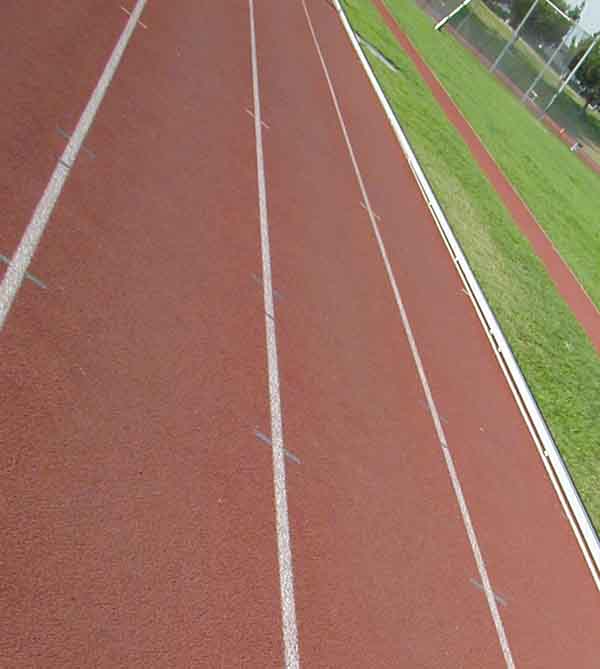 |
|
|
Here we go again with confused hurdle marks. By virtue of CSUN using the same
color, blue, to mark both 400H and 110H marks, when we get to the home stretch,
we get these confusing marks. In the foreground are the 400H marks, while just
a few yards farther away are the 110H marks. Since there is no stagger left
in the long race, they both go in all lanes at the same point. The only things
that help us here are 1) the spacing for the 110H would be obviously uneven
here (for that race) and 2) the fact that they have marked the reverse 110H
here and we know that mark is a constant 1 foot offset from the 110H in the
normal direction. Now try explaining this to the soccer team. I have run in
races at this track where the hurdles were put in the wrong place and here is
the reason why. |
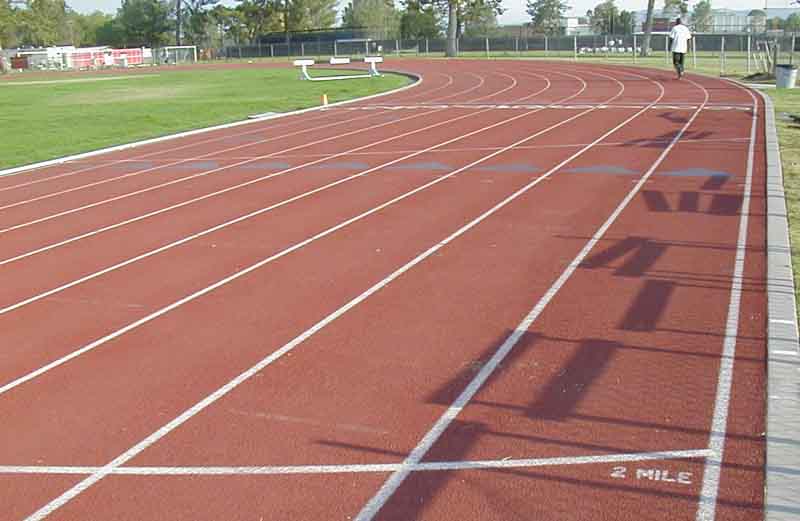 |
|
|
Hey, look at this. Just over 18m before the start line they even have a waterfall
start for the 2 mile. The next waterfall line is the 1 mile start located just
about the point on the beginning zone triangles. |
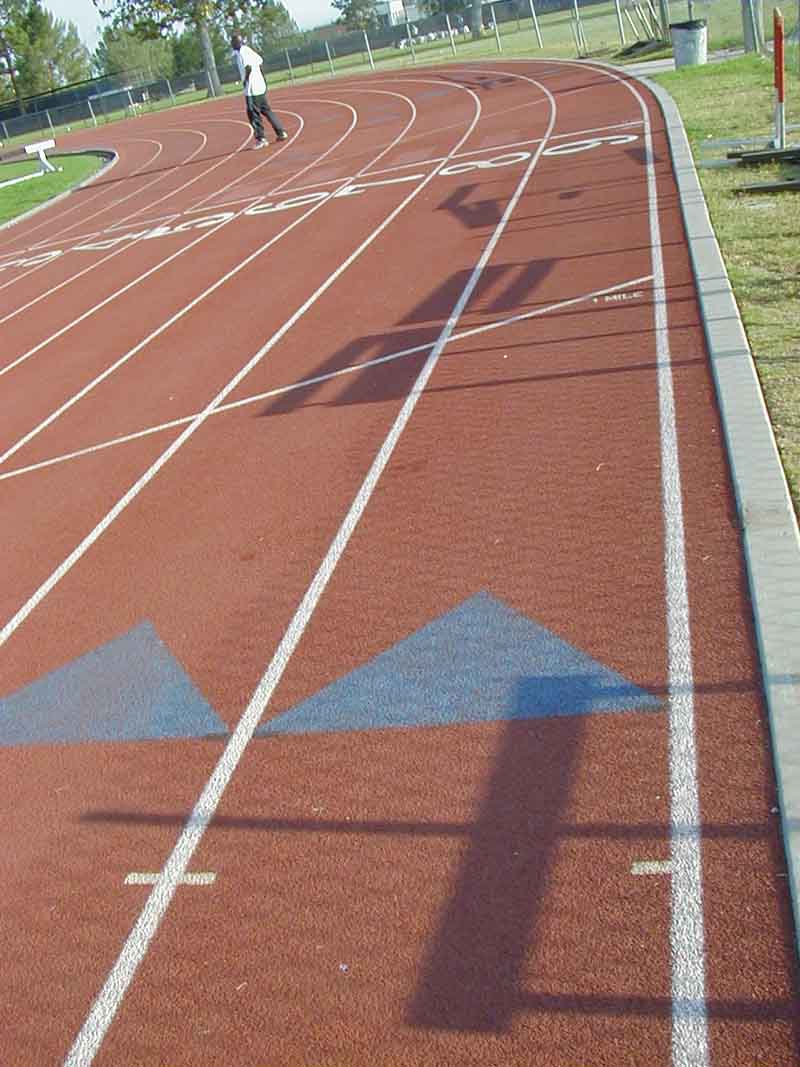 |
And as we get back to the common finish line we see, in the very foreground,
the final 100H mark (yellow), the blue triangle for the beginning of the
second and third 4x400 passing zone, a black (should be red) mark for
the 8th 300H and shortly after that the labeled end of the mile waterfall
start.
That pretty much covers all the different marks. On a properly marked
track, whether the colors are correct or not, all the marks should fall
into the same relative position to one another. If the track is an odd
distance, things certainly will be in a different place, but will still
be relative to one another (see Chaminade HS). If the straightaways are
short, alignment might be harder to percieve, but if something does not
match, either you have misidentified a line or the track you are on has
made a variation. As you can see from this track, they have four different
lines that can serve as finish lines. There are tracks that can have a
different finish line for every race (see Gilroy HS). The more they deviate
from the norm, the harder it is for you to figure out what they did, which
is the point. If the people who mark tracks would follow a standard and
not invent new ways of doing things for each track, there would be a lot
less confusion--this would be easier to teach. The standard is there,
written into our rulebooks--they all agree on the points I make. I didn't
write the rules but these rules define the way we operate our sport, so
everyone gets a fair and equal chance to do their event.
|
|
























